For flying drones in California, contact the FAA UAS Support Center (844-FLY-MY-UA) for general inquiries and register through the FAA DroneZone portal if your drone exceeds 0.55 pounds. Check the B4UFLY app for restricted zones near airports like LAX or SFO. Commercial operators need Part 107 certification, while recreational pilots must complete the TRUST test. For state parks, contact the District Superintendent directly. The proper permissions make all the difference between a smooth flight and potential fines!
Key Takeaways
- Contact the FAA UAS Support Center at 844-FLY-MY-UA for general drone operation inquiries in California.
- Reach the Western-Pacific Region FAA Office at (310) 725-7100 for California-specific airspace questions.
- Coordinate with California Department of Transportation when planning drone flights near highways or for events.
- Contact California Department of Fish and Wildlife for authorization to fly in protected natural areas.
- Consult local equipment suppliers for guidance on area-specific regulations and recommended gear.
Essential Contacts for Drone Pilots in California
The exciting world of drone piloting comes with important responsibilities, especially when flying in California’s diverse landscapes! Knowing who to contact is essential for safe, legal operations.
Your first stop should be the FAA UAS Support Center at 844-FLY-MY-UA, perfect for getting those burning questions answered before takeoff! For regional concerns, the Western-Pacific Region Office handles California airspace inquiries at (310) 725-7100. Many Equipment Suppliers can also guide you through local regulations while helping you gear up.
Planning a drone showcase? Event Sponsors often need to coordinate with local authorities and the California Department of Transportation’s Division of Aeronautics. Don’t forget about protected wildlife areas—you’ll need special authorization from the California Department of Fish and Wildlife. Remember, your local municipality may have additional restrictions too!
To ensure compliance with evolving regulations, consider equipping your drone with a FAA Compliant Remote ID Module for real-time identification and tracking.
FAA Registration Requirements for California Drone Owners
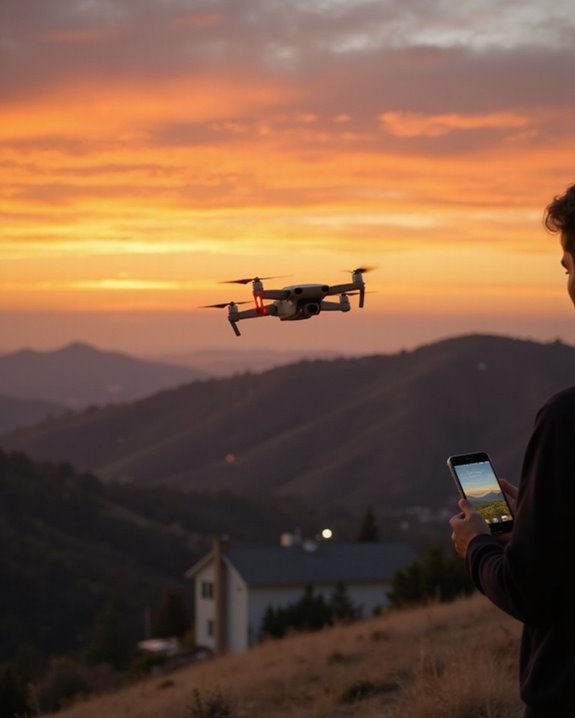
Every California drone owner must complete proper FAA registration before taking to the skies! The process is straightforward but absolutely essential for legal operation of your aerial companion.
The FAA enforces specific Weight Thresholds that determine registration requirements – any drone weighing more than 0.55 pounds (250 grams) must be registered through the FAA DroneZone portal for a modest $5 fee. Remember, your registration number must be visibly displayed on your drone’s exterior, much like a tiny license plate for your flying friend!
Don’t forget about the Renewal Process, as registrations are only valid for three years. Mark your calendar, drone enthusiasts! The requirements differ slightly between recreational and commercial pilots, with the latter needing to comply with Part 107 regulations and obtain a Remote Pilot Certificate.
To ensure compliance, using FAA registration stickers with durable, weather-resistant materials is highly recommended for clear and lasting identification.
Required Permits and Licenses for Different Drone Operations
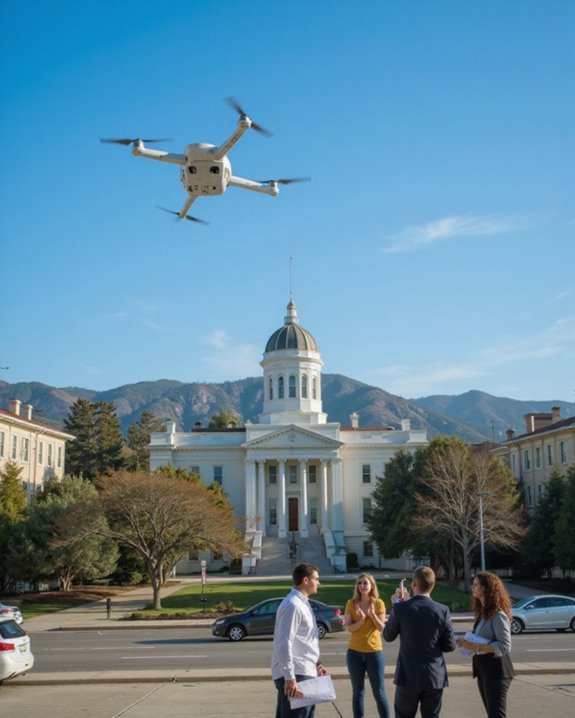
Various permits and licenses are required for drone operation in California, depending on whether you’re flying for fun or profit! Recreational pilots must complete the TRUST test and register drones weighing over 0.55 pounds, but generally don’t need a license for basic flights.
Commercial operators face stricter requirements, including the FAA Part 107 certification. All pilots, regardless of purpose, must meet certain standards – Pilot Age minimum of 16 years and English Proficiency to understand safety communications. There’s no wiggle room on that requirement! Additionally, compliance with Remote ID capabilities is becoming mandatory to ensure safe and legal drone operations.
California’s No-Fly Zones and Restricted Areas
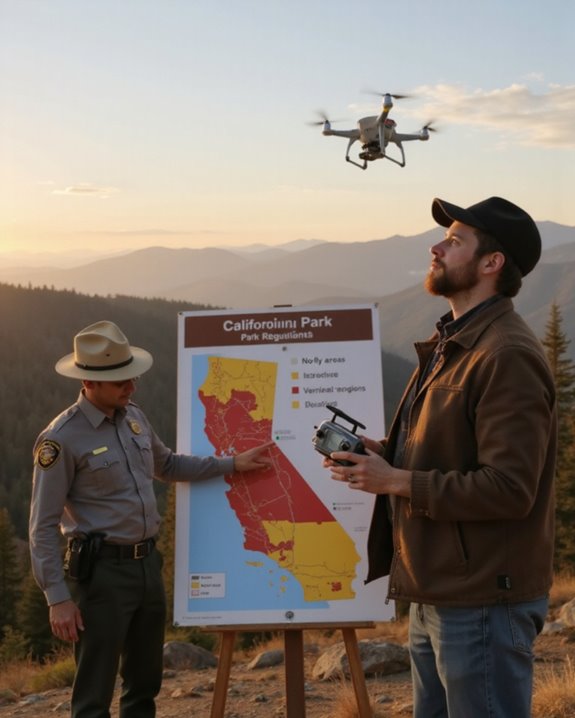
Drone flight restrictions across California create a complex patchwork of areas where your unmanned aircraft simply cannot go! Understanding Zone Evolution is vital as temporary restrictions can pop up during presidential visits, wildfires, or major sporting events.
Different Airspace Types exist throughout the Golden State, from permanent no-fly zones around airports like LAX and SFO to military installations such as Vandenberg Air Force Base. National parks, nuclear facilities, and high-security areas are also off-limits—no exceptions!
Smart pilots check the FAA’s B4UFLY app before every flight and watch for those distinctive “No Drone Zone” signs. Remember, violating these restrictions isn’t just inconvenient—it could cost you hefty fines! The good news? With proper research, you’ll still find plenty of legal airspace for your aerial adventures.
Local Authorities Overseeing Drone Activities in California
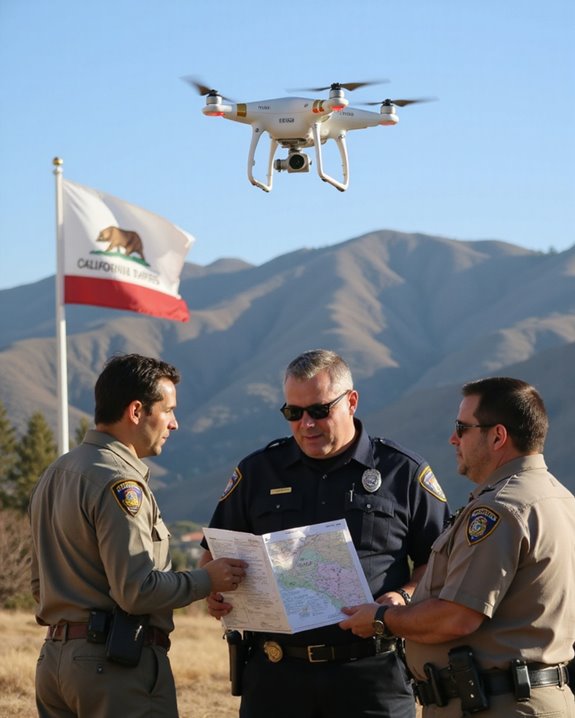
The complex web of drone regulations in California requires pilots to navigate multiple layers of oversight, from federal agencies down to your local city council! The California State Legislature creates foundational drone laws, while municipal governments establish specific ordinances that affect your neighborhood flying spots.
Authority Collaboration between state and local entities is essential for effective enforcement. The California Department of Transportation works alongside local law enforcement to monitor compliance, creating an integrated system of accountability. Many cities have developed Oversight Innovations, including specialized drone response units within police departments!
Special Permission for Flying in California State Parks
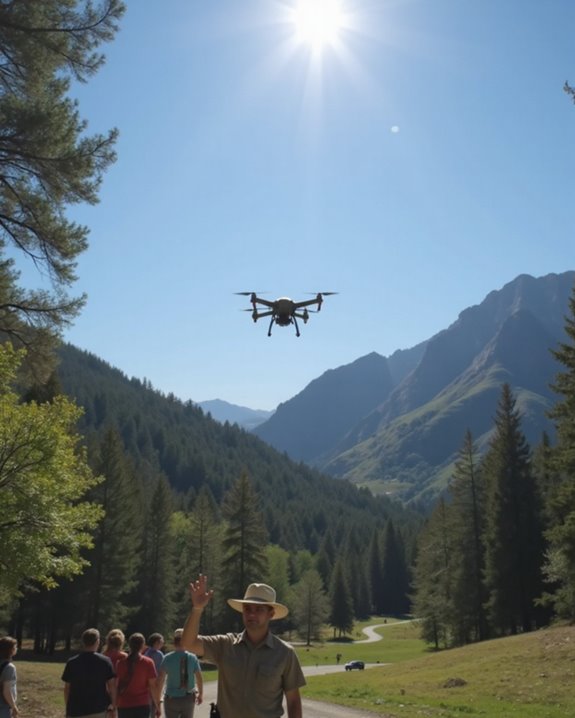
When planning your next aerial adventure within California’s magnificent state parks, you’ll need to understand exactly who to contact for special permission! Recreational drone flying is generally allowed in most state parks, but Drone Conservation and Permission Ethics require proper authorization in special circumstances.
For most state parks and beaches, no special permission is needed unless posted otherwise. However, drones are strictly prohibited in wilderness areas, cultural preserves, and natural preserves! Contact the District Superintendent directly if you need exceptions to these rules.
Commercial filming? You’ll need both an FAA Certificate of Authorization and approval from the California Film Commission. Scientific researchers must secure park unit permits too. Remember, these regulations exist to protect wildlife and cultural resources, not to clip your wings!
Safety Resources and Community Guidelines for California Pilots
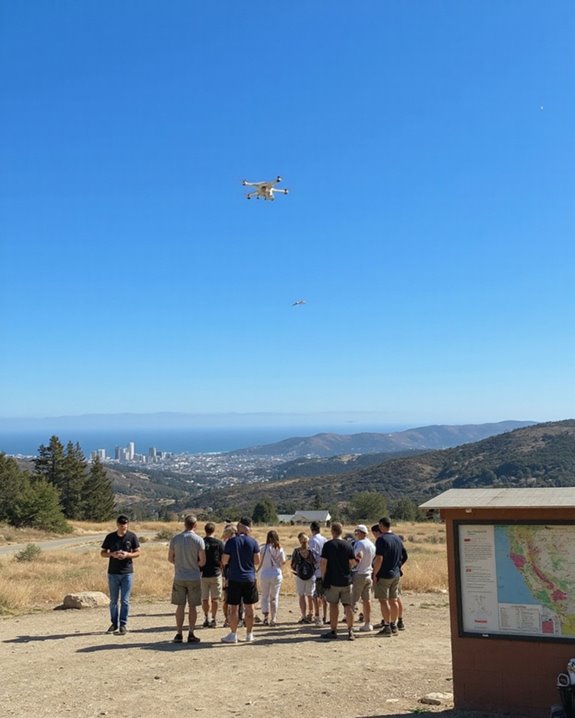
Handling California’s drone regulations requires more than just a remote controller and excitement—you’ll need proper safety resources and community guidelines at your fingertips!
California pilots must complete the Recreational UAS Safety Test (TRUST) and register drones over 0.55 lbs for a $5 fee. The FAA’s B4UFLY and other Safety Apps are invaluable tools for checking airspace restrictions before launching your drone. Remember, you must always maintain visual line-of-sight and stay below 400 feet!
Local Training Workshops and community forums provide excellent opportunities to connect with fellow enthusiasts while honing your skills. These resources help you navigate California’s complex drone landscape, from Remote ID requirements to no-fly zones. Insurance isn’t mandatory but highly recommended—because nobody plans to crash into their neighbor’s prized rosebush!
Emergency Contacts When Flying in Sensitive Areas
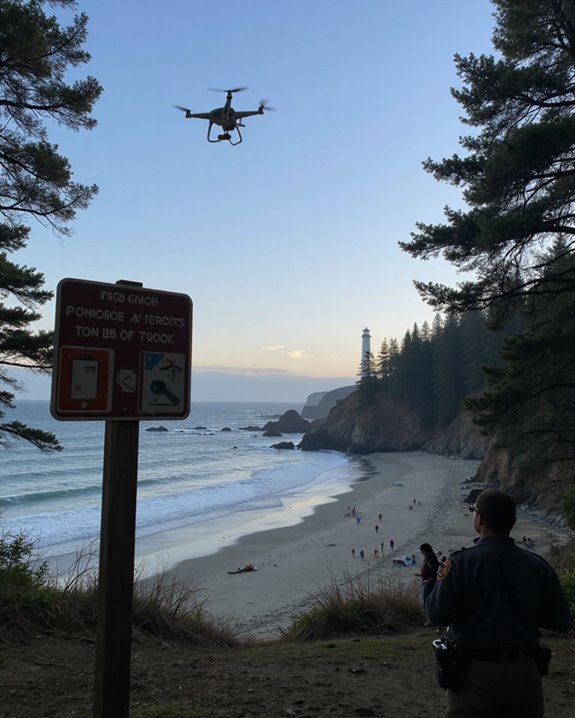
Flying drones near emergency operations or sensitive areas raises critical questions about who to contact if something goes wrong! When operating within 5 miles of airports, pilots must contact the airport authority or control tower first—no exceptions, even for those with excellent Pilot Training credentials.
For emergency situations where drones interfere with first responders, immediately call local law enforcement. Remember, California’s AB 1680 makes such interference a crime! Regular Drone Maintenance helps prevent unexpected failures that could create emergency situations in sensitive zones.
If you spot unauthorized drones near wildfires, contact Cal Fire immediately. For airport vicinity concerns, the FAA’s LAANC system provides proper authorization channels. Keep these contacts handy on your pre-flight checklist—right next to your battery check and weather assessment!
Frequently Asked Questions
How Do I Report Someone Flying a Drone Irresponsibly?
Individuals can use established Report Methods by contacting local law enforcement for immediate concerns or the FAA’s Flight Standards District Office for airspace violations. Incident Logging through official channels guarantees proper investigation of irresponsible drone operations.
Can I Fly My Drone at California Beaches?
Drone flying is generally permitted at California beaches that are State Parks, though certain locations have specific prohibitions. Operators should check with local State Park Districts regarding Beach Permissions and be mindful of Wildlife Concerns.
Are There Altitude Restrictions for Drones in Residential Areas?
Like an invisible ceiling, drone operators face strict altitude limits in residential areas. Federal regulations cap flights at 400 feet AGL, while California imposes additional residential height restrictions, particularly near schools and private properties.
What Insurance Options Are Recommended for Recreational Drone Pilots?
Recreational drone pilots have several insurance options through providers like BWI Aviation Insurance. Coverage types typically include liability protection of around $500,000 and optional hull damage insurance for the drone itself.
How Do International Visitors Obtain Temporary Drone Flying Permissions?
International visitors must follow FAA requirements based on usage type. For recreational flying, they need TRUST certification. Commercial operators require a Part 375 permit through online application. Visa requirements don’t specifically affect drone operation permissions.





